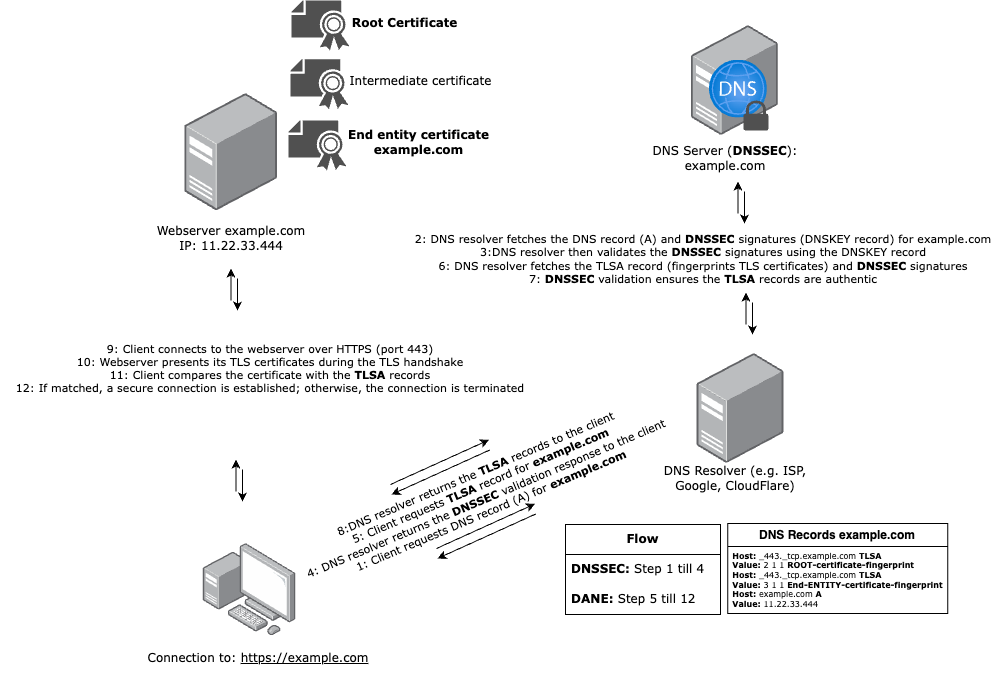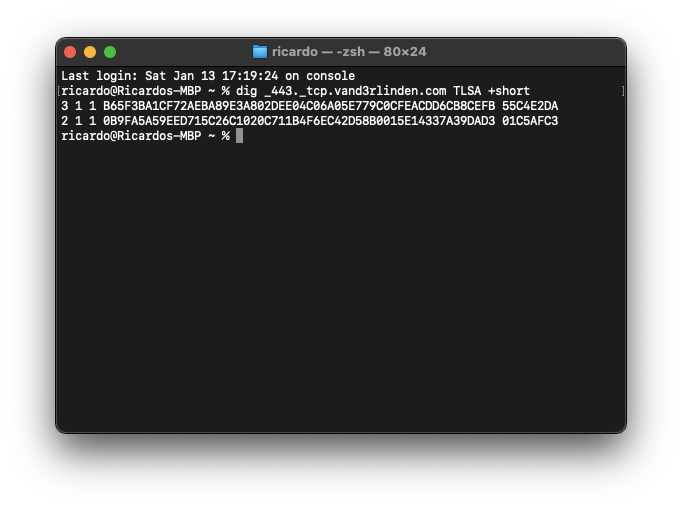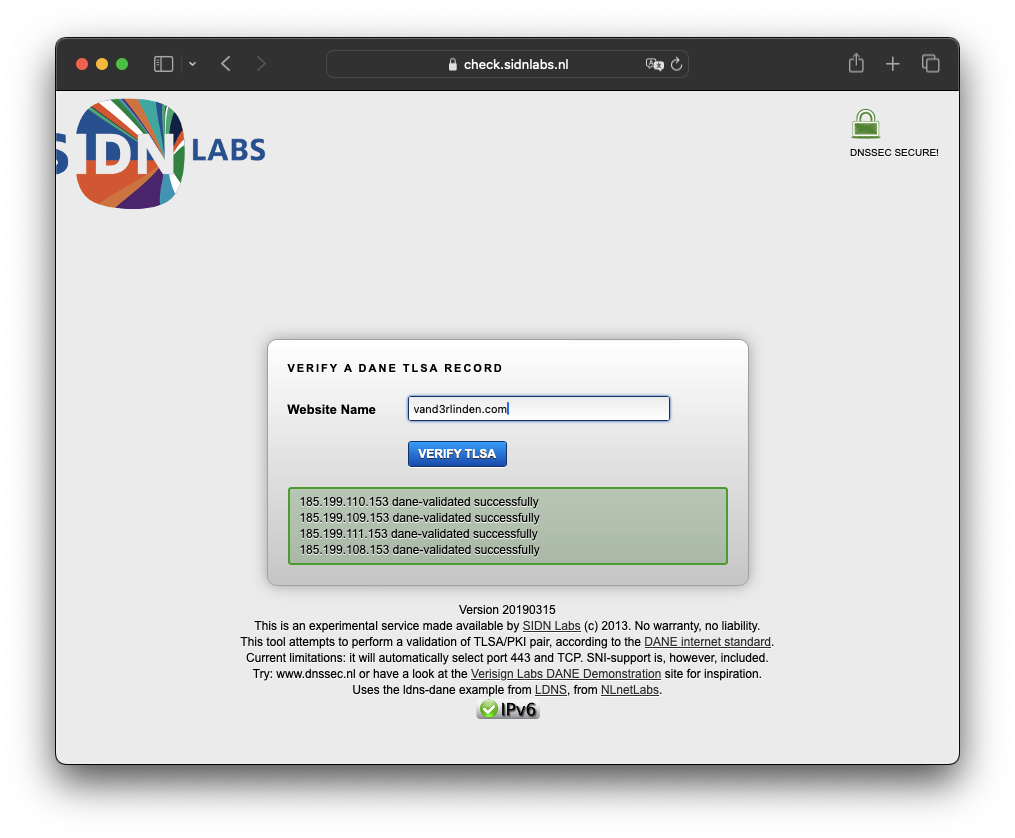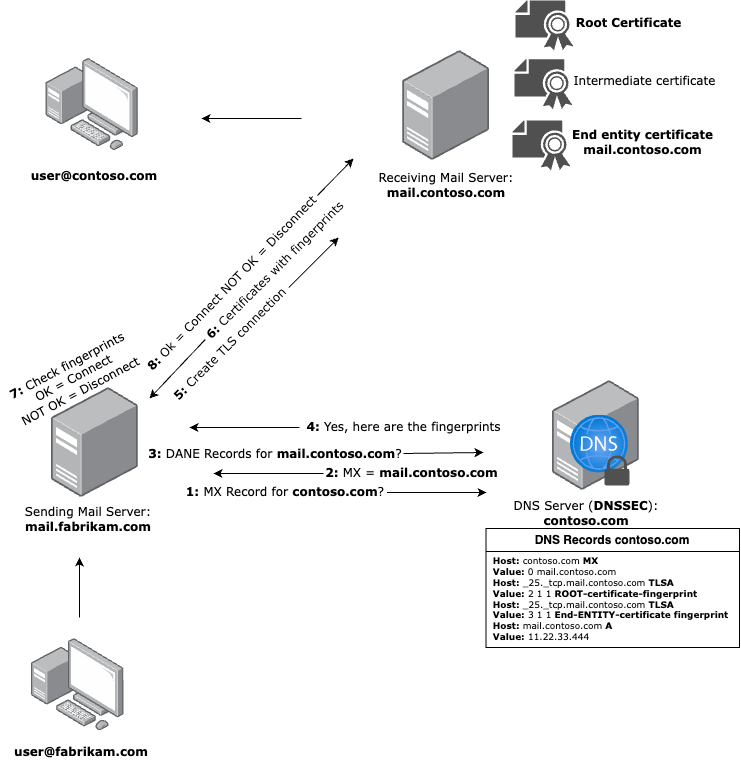In this post, you find out how DNSSEC and DANE cooperate, and learn how to set up DANE TLSA DNS records.
DNSSEC (DNS Security Extensions)
The domain name system (DNS) is often described as the phone book of the internet for translating friendly domain names into IP addresses. Unfortunately, it also accepts any address given to it. DNSSEC adds a security layer to this phonebook. It uses digital signatures to make sure the information in the phonebook can be trusted and has not been tampered with, to prevent DNS spoofing.
DNSSEC can be enabled with your DNS provider if they support it.
DANE (DNS-based Authentication of Named Entities)
DANE used the DNS infrastructure to store details about the security of a service, such as the public key (fingerprint) of a certificate. These details act as a special seal of approval, ensuring that when your computer talks to this service, it’s real and it’s safe. DANE uses the TLSA (Transport Layer Security Authentication) record type, which allows users to verify the security details from a service (such as a web or mail server) by querying the DNS for its information.
DANE relies on DNSSEC and only works when DNSSEC is enabled.
Implementation of DANE
You can implement DANE with a TLSA record at your DNS hosting provider:
_port._protocol.yourdomain.comINTLSAusage-selector-matching certificate-fingerprint
For example, on port 443 (your web server):
_443._tcp.yourdomain.comINTLSA2 1 1 0B9FA5A59EED...(Root certificate)_443._tcp.yourdomain.comINTLSA3 1 1 0D073B9B73B4...(Host certificate)- 3:
usage - 1:
selector - 1:
Matching-Type
- 3:
The certificate usage type can be one of the following:
- 0: PKIX-TA (Trust Anchor)
- 1: PKIX-EE (End Entity)
- 2: DANE-TA (Trust Anchor Assertion: Intermediate / Root certificate)
- 3: DANE-EE (End Entity Assertion: Host certificate / Server certificate such as yourdomain.com)
The selector specifies how the certificate is presented:
- 0: Full certificate (not recommended)
- 1: SubjectPublicKeyInfo (recommended)
The Matching-Type specifies how the certificate association is verified:
- 0: No hash used (not recommended)
- 1: SHA-256 hash (recommended)
- 2: SHA-512 hash (not recommended / less supported)
DNSSEC and DANE on a webserver
By combining DNSSEC and DANE, the integrity and authenticity of both the DNS responses and the TLS certificates are ensured, providing a robust mechanism to prevent man-in-the-middle attacks and improving overall webserver trust.
The flow of DNSSEC and DANE on a webserver

Example for this site, TLSA records:

Verify DANE TLSA records:
 Source: https://check.sidnlabs.nl/dane/
Source: https://check.sidnlabs.nl/dane/
DNSSEC and SMTP DANE on a mailserver
SMTP DANE is a security mechanism that uses DNSSEC to allow a sending (outbound) mail server to verify the TLS certificate of a receiving (inbound) mail server using TLSA records published in the DNS of the receiving domain. This helps ensure that TLS connections between mail servers cannot be intercepted or downgraded, protecting against attacks such as TLS downgrade and man-in-the-middle attacks.
Since port 25 does not use authentication (MTA-to-MTA delivery), implementing SMTP DANE enforces TLS encryption and certificate validation between MTA’s, this ensures the confidentiality of email delivery.
The flow of SMTP DANE on a mailserver
- Outbound SMTP DANE with DNSSEC
sending mail server: Requests DANETLSArecords of the receiving domain’sMXrecord. - Inbound SMTP DANE with DNSSEC
receiving mail server: Requires DNSSEC and DANETLSArecords that can be requested by the sending mail server.

To Summarize
The use of DNSSEC and DANE is critical to strengthening online security. DNSSEC ensures data integrity and authentication in the DNS, while DANE associates digital certificates with domain names to prevent unauthorized access. Together, they form a powerful defense against evolving cyber threats, promoting trust and improving overall Internet security.
